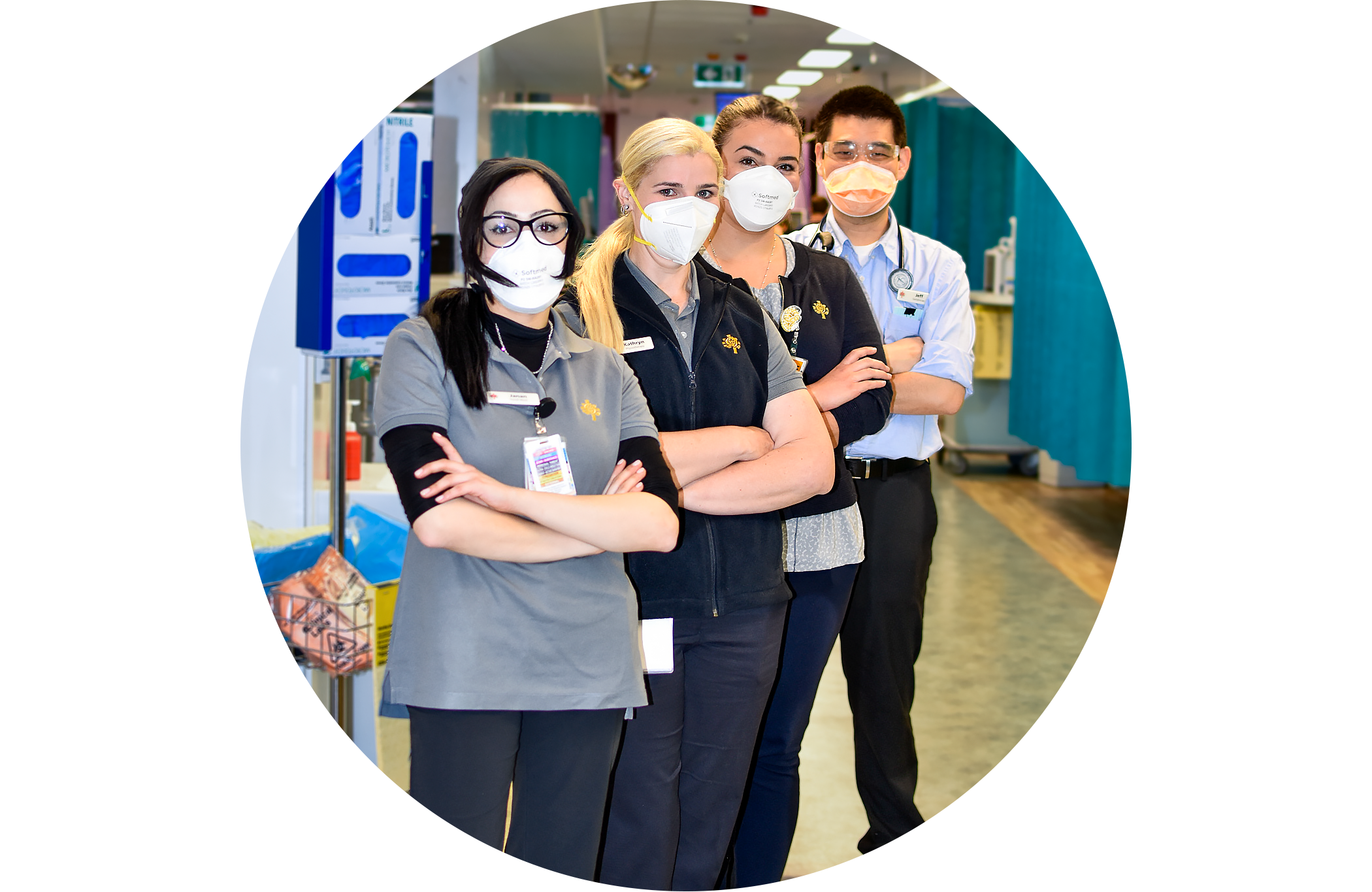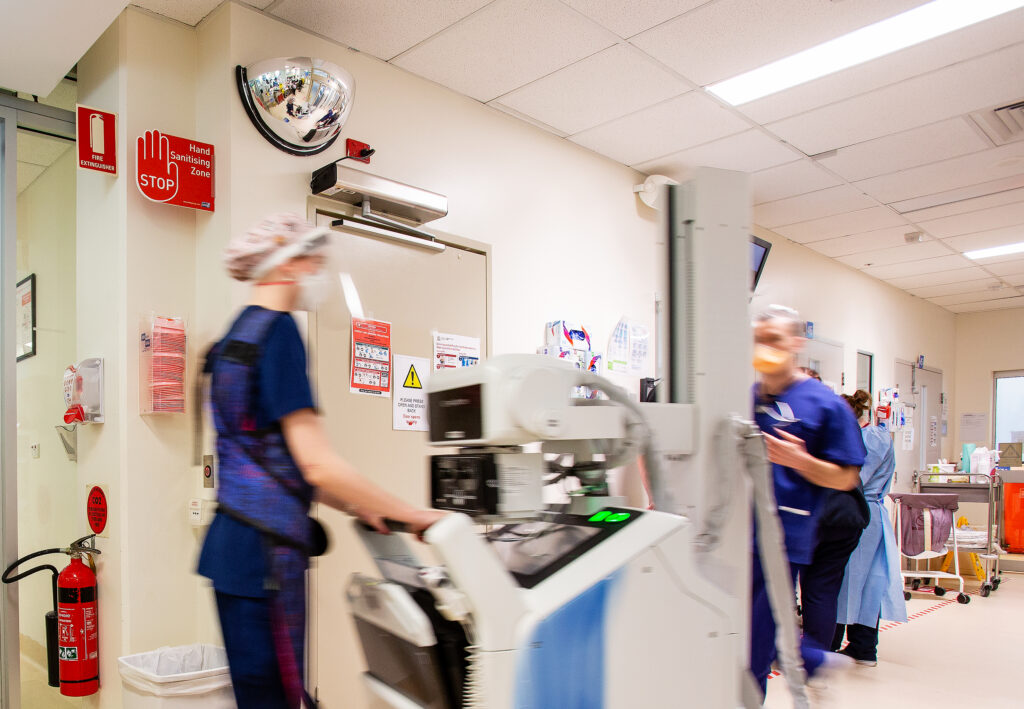Demand
Patients seeking hospital care have the best chance of making a good recovery if they receive the right care within clinically recommended timeframes.
Delays in care beyond these timeframes increase the patient’s risk of a poor, or even harmful, outcome. That is why EMHS hospitals – like all healthcare facilities – strive to meet these targets. The WA Emergency Access Target — WEAT — and WA Elective Services Target — WEST — are two measures used to gauge the performance of our hospitals in meeting this goal.
To meet our WEAT, 90% of patients who present to our EDs must be seen and either admitted, transferred or discharged within four hours of arrival.
WEST highlights the percentage of patients on EMHS elective surgery waitlists who are over-boundary — in other words — who have not been treated within the designated clinically appropriate timeframe.

Elective surgery
Elective services patients are prioritised based on their assigned clinical urgency category:
- Category 1 — clinically indicated within 30 days
- Category 2 — clinically indicated within 90 days
- Category 3 — clinically indicated within 365 days.
Restrictions imposed on elective surgery at the start of 2022 due to COVID impacted progress EMHS had made on reducing elective surgery waitlists. These pre-restriction initiatives had started to make significant inroads, including an 85% cut in over-boundary endoscopy cases between July and December 2021. Cancellation of all Category 3 procedures and less urgent Category 2 procedures set back this progress. This was compounded by patients and staff also being impacted by COVID.
Since the lifting of all restrictions towards the end of the reporting period, EMHS staff have been working hard to implement both short and long-term strategies to regain lost ground (see relevant KPI here).
Emergency access
Emergency access and demand continued to stretch our services in 2021-22. This was due in part to the impact of COVID on staffing levels, not just from staff who were ill themselves, but also staff who were required to furlough or care for isolating family members. On occasions, lack of staff led to bed or ward closures, further impacting patient flow and emergency access.
Percentage of patients seen within recommended times – performance indicator
The Australasian College for Emergency Medicine (ACEM) developed the Australasian Triage Scale (ATS) to ensure that patients presenting to EDs are medically assessed, prioritised according to their clinical urgency and treated in a timely manner.
This performance indicator measures the percentage of patients being assessed and treated within the required ATS timeframes. This provides an overall indication of the effectiveness of WA’s EDs, which can assist in driving improvements in patient access to emergency care.
ATS category targets are outlined below:
| Triage category | Treatment acuity (maximum waiting time for medical assessment and treatment) | Target (threshold) |
|---|---|---|
| 1 | Immediate (≤ 2 minutes) | 100% |
| 2 | ≤ 10 minutes | 80% |
| 3 | ≤ 30 minutes | 75% |
| 4 | ≤ 60 minutes | 70% |
| 5 | ≤ 120 minutes | 70% |
These recommended times and categories are used both locally by WA Health and nationally by the Department of Health and Ageing, and the Australian Institute of Health and Welfare.
2021-22 triage results
Triage category 1:
| Year | Target | Actual | |
|---|---|---|---|
| Year 2021-22 | Target 100% | Actual 99.6% |
|
| Year 2020-21 | Target 100% | Actual 100% |
|
| Year 2019-20 | Target 100% | Actual 99.8% |
|
Triage category 2:
| Year | Target | Actual | |
|---|---|---|---|
| Year 2021-22 | Target 80.0% | Actual 68.0% |
|
| Year 2020-21 | Target 80.0% | Actual 79.2% |
|
| Year 2019-20 | Target 80.0% | Actual 84.0% |
|
Triage category 3:
| Year | Target | Actual | |
|---|---|---|---|
| Year 2021-22 | Target 75.0% | Actual 18.8% |
|
| Year 2020-21 | Target 75.0% | Actual 31.0% |
|
| Year 2019-20 | Target 75.0% | Actual 43.0% |
|
Triage category 4:
| Year | Target | Actual | |
|---|---|---|---|
| Year 2021-22 | Target 70.0% | Actual 41.5% |
|
| Year 2020-21 | Target 70.0% | Actual 51.5% |
|
| Year 2019-20 | Target 70.0% | Actual 63.6% |
|
Triage category 5:
| Year | Target | Actual | |
|---|---|---|---|
| Year 2021-22 | Target 70.0% | Actual 78.1% |
|
| Year 2020-21 | Target 70.0% | Actual 83.8% |
|
| Year 2019-20 | Target 70.0% | Actual 89.8% |
|
Period: 2019-20 to 2021-22 financial years
Contributing sites: Armadale Health Service, Royal Perth Hospital, St John of God Midland Public Hospital
Data source: Emergency Department Data Collection
EMHS performance against the ATS has declined in 2021-22 for all triage categories (with most notable decline in triage categories two, three and four).
This has been significantly impacted by a sustained increase in demand, with 213,508 ED presentations in 2021-22 compared with 204,989 in 2019-20, as well as increased complexity and acuity of patients attending across EMHS sites.
EMHS has established the Emergency Access Program (EAP), which aims to improve emergency access through focused initiatives across EMHS sites. It is intended to drive site-based and system-wide change, aimed at reducing pressure on EDs and improving timely access to care for patients requiring emergency services.
To improve performance, during 2021-22 EMHS has continued its focus on three key areas:
- timely transfer of care — emergency ambulance transfer of care within 30 minutes of arrival
- discharge WEAT — timely discharge of patients from the ED
- ED patient flow to wards — timely transfer of a patient from ED to the wards.

Midland’s Geriatric ED Team
Site strategies to improve WEAT performance
Key initiatives within the EAP include the Comprehensive Ambulatory Older Adult Program (CAOAP), which aims to streamline access for older adult patients. The CAOAP comprises projects across sites including:
- The Ambulatory Frailty Unit at RPH has been established and provides a multi-purpose area for acute care and assessments, and enables pathways for direct admission. The unit has been successful in preventing multi-day admissions by providing comprehensive same-day care.
- At Midland, the multidisciplinary Geriatric ED team’s objective is to avoid hospital admission or re-admission by providing rapid and targeted assessment and interventions based on the goals of patient care. The team provides early comprehensive multidisciplinary assessment and management of the frail older person presenting from the community and RACF.
- The Individualised Home Support Service (IHS) at RPH works closely with the Ambulatory Unit and provides rapid allied health and non-clinical support (personal care and home assistance services) in the home to address social and reablement needs, and facilitates timely and safe discharge from hospital. Primary focus remains on discharging patients from hospital or ED as soon as they are medically stable and assessing their ongoing needs at home through a dedicated nursing, allied health and non-clinical support team.
- The Community Health In a Virtual Environment (Co-HIVE) pilot has delivered remote monitoring of residents across two Residential Aged Care Facilities (RACFs) to provide proactive geriatric in-reach to consumers, either initiated by RACF nursing staff or through clinical discussion with the Co-HIVE team at RPH.
- AHS has facilitated patient flow and hospital avoidance by implementing a Frailty Pathway via the Older Adult Liaison Service, which optimises the patient journey in ED, inpatient and ambulatory settings.
A number of infrastructure changes were also made to improve ED access and patient flow. RPH’s ED was reconfigured, with the addition of two private consult rooms and three new treatment bays.
At AHS, completion of the ED upgrade incorporated a priority paediatric treatment area, waiting room, improved area for mental health patients, and enhanced spaces for ambulatory and respiratory assessments.

Mental health
The needs of people experiencing mental ill-health can vary greatly depending on their personal circumstances and the complexity and acuity of their condition.
While some may require a hospital admission, others may benefit from interventions provided by community mental healthcare services.
EMHS recognises the importance of providing a range of integrated services to meet the varying needs of patients and patient cohorts. It also understands that for consumers to gain maximum benefit from these services, the services must be well coordinated and work together for the benefit of the consumer.
EMHS mental health service provision includes:
- information, guidance and crisis response
- community-based non-admitted care
- admitted (inpatient) care
- residential and transitional care.
During 2021-22, EMHS launched several new mental health services and programs. Covering all forms of service provision — from information, guidance and crisis response, to residential and transitional care. We also catered to both general populations and specific consumer cohorts, such as young people and people experiencing — or at risk of — homelessness (learn more).
In addition to these service developments, EMHS also strengthened our processes for coordinating care.
In March 2022, a proof of concept was completed for a virtual mental health service in collaboration with the EMHS Community Mental Health Services. This service, called Co-HIVE, seeks to remotely monitor the physiological and mental health of community-based consumers with depression, and intervene proactively to aid quicker and more complete recovery.
The service utilises wearable devices and mobile applications to support community consumers to proactively manage their mental healthcare at home, with the support of a virtual clinical workforce.
An evaluation of the proof of concept was undertaken and as a result, a larger pilot of the service will commence in 2022-23.
These developments saw EMHS continue to deliver on our commitment to recommendation 7 of the SHR, which calls for the implementation of models of care for people to access responsive and connected mental health, alcohol and other drugs services in the most appropriate setting.


